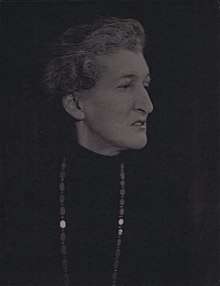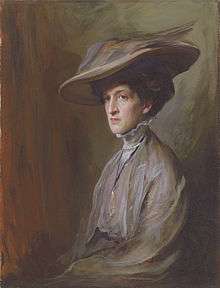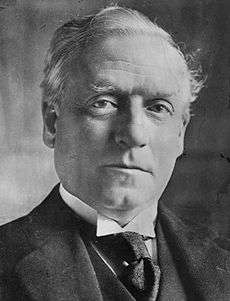Margot Asquith
Emma Margaret Asquith, Countess of Oxford and Asquith (née Tennant; 2 February 1864 – 28 July 1945), known as Margot Asquith, was a British socialite, author, and wit. She was married to H. H. Asquith, Prime Minister of the United Kingdom, from 1894 until his death in 1928.
The Countess of Oxford and Asquith | |
|---|---|
 Margot Asquith | |
| Spouse of the Prime Minister of the United Kingdom | |
| In role 5 April 1908 – 5 December 1916 | |
| Preceded by | Vacant |
| Succeeded by | Margaret Lloyd George |
| Personal details | |
| Born | Emma Margaret Tennant 2 February 1864 Peeblesshire (Tweeddale), Scotland |
| Died | 28 July 1945 (aged 81) London, England |
| Resting place | All Saints' Church, Sutton Courtenay |
| Spouse(s) | |
| Children | 5, including |
| Parents | Sir Charles Tennant, Bt (father) |
| Relatives |
|
Early life
Emma Margaret Tennant was born in Peeblesshire, of Scottish and English descent, the sixth daughter and eleventh child of Sir Charles Tennant, 1st Baronet, an industrialist and politician, and Emma Winsloe. Known always as Margot, Tennant was brought up at The Glen, the family's country estate; Margot and her sister Laura grew up wild and uninhibited. Margot was a "venturesome child", for example roaming the moors, climbing to the top of the roof by moonlight, riding her horse up the front steps of the estate house. Riding and golf were her lifelong passions.
The two girls were inseparable, entering society together in London in 1881. She and Laura became the central female figures of an aristocratic group of intellectuals called "The Souls" ("You are always talking about your souls," complained Lord Charles Beresford, thereby providing them with a suitable label). When Laura married Alfred Lyttelton in 1885, the first part of Margot's life ended. Laura's death in 1888 was a devastating blow from which Margot never fully recovered. As a result, Margot developed chronic insomnia which would plague her for the rest of her life.
Mrs Asquith
_Asquith_(n%C3%A9e_Tennant)%2C_Countess_of_Oxford_and_Asquith.jpg)
On 10 May 1894, Margot married H. H. Asquith and became a "spur to his ambition". She brought him into the glittering social world, which he had in no way experienced with his first wife. However Margot had known her slightly and she always spoke of her warmly. Asquith also became an unenthusiastic stepmother to five children who were bemused by this creature, so different from their quiet mother. "She flashed into our lives like some dazzling bird of paradise, filling us with amazement, amusement, excitement, sometimes with a vague uneasiness as to what she might do next," wrote Violet Asquith.
In 1908, when Asquith became prime minister, Violet was the only child of his first wife still at home, and the two shared a deep interest in politics. In contrast, relations between stepmother and stepdaughter were frequently strained, prompting H. H. Asquith to write lamentingly of how the two were 'on terms of chronic misunderstanding.'[1]
A huge house in Cavendish Square in London with a staff of 14 servants was the Asquith home until they moved to the prime minister's residence at 10 Downing Street in 1908. The residence of most importance in the life of the Asquiths was The Wharf in Sutton Courtenay, Oxfordshire, built in 1912. This became their weekend home away from home. It is here that literary, artistic and political luminaries would gather.
Asquith was a staunch opponent of women's suffrage, once saying in a letter that 'women have no reason, very little humour, hardly any sense of honour...and no sense of proportion.' [2] On holiday in 1909 in Clovelly Court, Devon the Asquiths were followed by suffragettes Elsie Howey, Jessie Kenney and Vera Wentworth, whom Margot recognised again at church and they also hid in her garden, covering plants with the colours of the movement purple, white and green.[2] She attended the debate on the aborted Conciliation Bill with other politicians wives, and in 1911 she 'seemed highly amused at the earnestness' of women's suffrage lobbyists, whilst near to Constance Lytton and Annie Kenney, who remembered her as unpleasant and sarcastic .[2] In 2012 an article in Votes for Women told of Asquith's 'stealth' journey when travelling with her husband as Prime Minister via Wolverhampton and Holyhead ferry to Dublin, when their ferry was still met by a yacht of Irish Womens' Franchise League demanding the female vote be included in the Irish Home Rule Bill.[2]
Asquith bore five children, only two of whom survived infancy. Elizabeth Asquith, born in 1897, married Prince Antoine Bibesco of Romania in 1919 and became a writer of some note. Anthony Asquith, born in 1902 became a leading English film director.
During World War I Margot Asquith's outspokenness led to a public outcry. For example, she visited a German prisoner of war camp, and she accused her shell-shocked stepson Herbert of being drunk. The negative public and media response may well have contributed to the political downfall of her husband. In 1918 she was publicly attacked in court by Noel Pemberton Billing, a right-wing MP, who was convinced that the nation's war effort was being undermined by homosexuality in high society. He hinted that she was associated with the conspirators.[3] Billing also published a poem written by Lord Alfred Douglas which referred to "merry Margot, bound With Lesbian fillets".[4]
After the war

In 1920 the mansion in Cavendish Square was sold and the Asquiths moved to 44 Bedford Square, a beautiful house formerly occupied by salonière Ottoline Morrell. She became Countess of Oxford and Asquith in 1925 when her husband was granted a peerage.
In the late 1920s Margot and her husband were seriously in debt: she admitted to owing £15,000 (over £800,000 at 2015 prices) and having pawned her pearls for £2,000 despite, she claimed, having made £18,000 from books and £10,000 from various writings. A whipround of Liberal sympathisers had to be organised to provide for them. Her husband left her only £300 (just over £16,000 at 2015 prices) on his death in 1928 as he had to use his life insurance to provide for his children. She was left in near penury and her financial position caused her constant concern. Thereafter she made money by advising on “matters of taste” in interior design and advertising Wix cigarettes, often issued "IOU"s which she hoped would never be cashed and, beginning before her husband's death, was given regular gifts of money by Lord Beaverbrook.[5][6]
Her writing style was not always critically accepted—the most famous review of Margot's work came from New York wit Dorothy Parker, who wrote, "The affair between Margot Asquith and Margot Asquith will live as one of the prettiest love stories in all literature."[7] Margot was known for her outspokenness and acerbic wit. A possibly apocryphal but typical story has her meeting the American film actress Jean Harlow and correcting Harlow's mispronunciation of her first name – "No, no; the 't' is silent, as in 'Harlow'."[8] The story was recorded by the Liberal MP Robert Bernays in his diary entry for 26 June 1934, but Bernays does not claim to have witnessed the alleged encounter himself.[9]
After her husband's death Margot slowly moved down the residential rungs to rooms at the Savoy Hotel. Her final home was in Thurloe Place, Kensington.
She told Harold Nicolson that Neville Chamberlain was "the greatest Englishman that ever lived" for signing the Munich Agreement.[10]
Her final overwhelming sadness was the separation from her daughter, Elizabeth, who had been trapped in Bucharest since 1940. Margot schemed for her rescue, but Elizabeth died of pneumonia in April 1945; heart-broken, she outlived her daughter by only a few months.
Margot's diaries covering 1914–16 were published by Oxford University Press in June 2014 as Margot Asquith's Great War Diaries.[11]
Publications
- An Autobiography, 1920
- My Impressions of America, 1922
- Places & Persons, 1925
- Lay Sermons, 1927
- Octavia, 1928
- More Memories, 1933
- More or Less about Myself, 1934
- "Off the Record", 1943
Arms
  |
|
References
- Pottle, Mark (May 2007). "Carter, (Helen) Violet Bonham, Baroness Asquith of Yarnbury (1887–1969)". Oxford Dictionary of National Biography, online ed. (subscription required). Oxford University Press. Retrieved 15 April 2014.
- Atkinson, Diane (2018). Rise up, women! : the remarkable lives of the suffragettes. London: Bloomsbury. pp. 46, 148, 209, 337. ISBN 9781408844045. OCLC 1016848621.
- See also Kettle, Michael. Salome's Last Veil: The Libel Case of the Century, London: Granada, 1977; Jodie Medd, "'The Cult of the Clitoris': Anatomy of a National Scandal," Modernism/Modernity 9, no. 1 (2002): 21–49 doi:10.1353/mod.2002.0015
- Philip Hoare, Oscar Wilde's Last Stand: Decadence, Conspiracy, and the Most Outrageous Trial of the Century, Arcade Publishing, 1999, p. 110.
- Koss 1985, pp282-3
- "Compute the Relative Value of a U.K. Pound". Archived from the original on 31 March 2016. Retrieved 24 October 2016.
- Parker, Dorothy (as Constant Reader.) "Re-enter Margot Asquith – A Masterpiece from the French", The New Yorker, 22 October 1927. Reprinted in Parker, Dorothy, Constant Reader, Viking Press, 1970, p. 10-11.
- Byrne, Robert. The 2,548 Best Things Ever Said (1996). New York; Galahad Books.
- Smart, Nick, ed. The Diaries and Letters of Robert Bernays, 1932–1939 (1996), p. 144. Lewiston, Queenston, and Lampeter: The Edwin Mellen Press.
- Nigel Nicolson (ed.), Harold Nicolson. Diaries and Letters 1930–1939 (London: Collins, 1966), p. 371.
- "'Insolent' Churchill, 'ignorant' Kitchener: waspish wartime diaries of Margot Asquith". The Guardian. 8 June 2014. Retrieved 10 June 2014.
Further reading
- Ellenberger, Nancy W. Balfour's World: Aristocracy and Political Culture at the Fin de Siècle (2015). excerpt
- Jenkins, Roy (1964). Asquith (first ed.). London: Collins. OCLC 243906913.
- Koss, Stephen (1985). Asquith. London: Hamish Hamilton. ISBN 978-0-231-06155-1.
Primary sources
External links
| Wikiquote has quotations related to: Margot Asquith |
| Wikimedia Commons has media related to Margot Asquith. |
- Works by Margot Asquith at Project Gutenberg
- Works by or about Margot Asquith at Internet Archive
- Full text of Margot Asquith, An Autobiography from Project Gutenberg
- "Archival material relating to Margot Asquith". UK National Archives.

- Bodleian Library catalogue of Margot Asquith's private papers
- Bodleian Library catalogue of H.H. Asquith's private papers
- Bodleian Library catalogue of Lady Violet Bonham Carter's private papers
- Newspaper clippings about Margot Asquith in the 20th Century Press Archives of the ZBW
| Unofficial roles | ||
|---|---|---|
| Vacant Title last held by The Lady Campbell-Bannerman |
Spouse of the Prime Minister of the United Kingdom 1908–1916 |
Succeeded by Margaret Lloyd George |
.svg.png)
